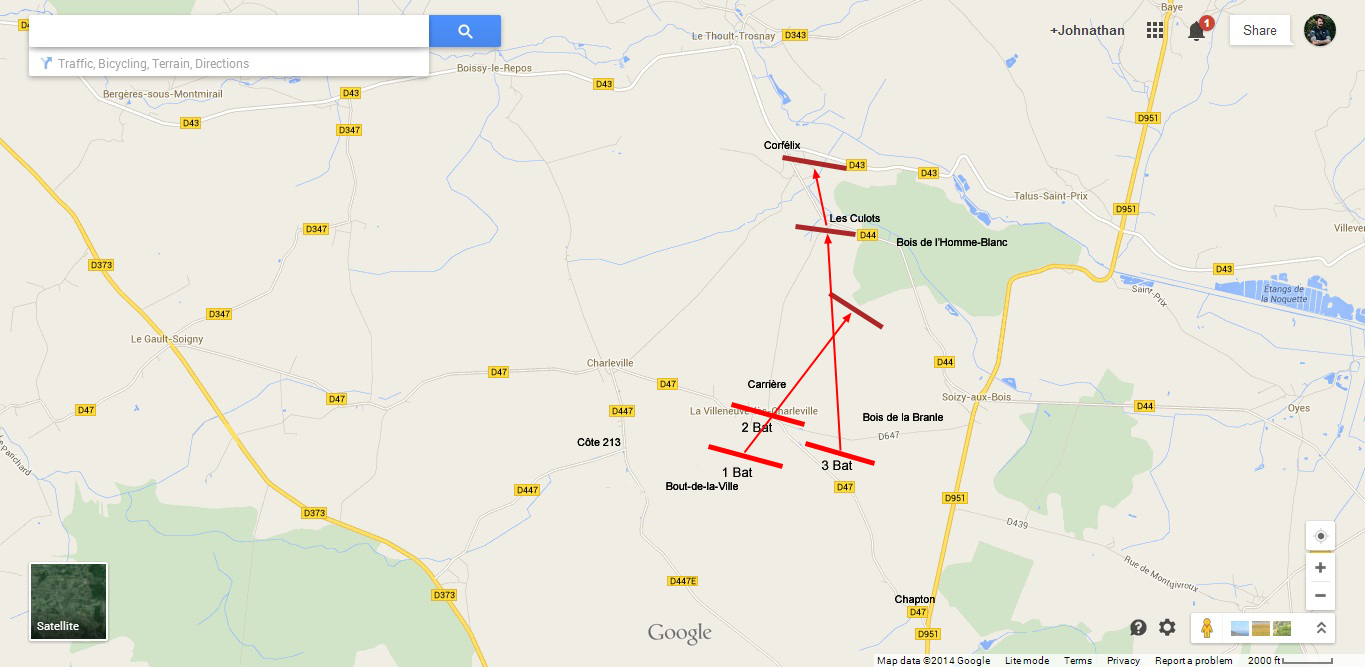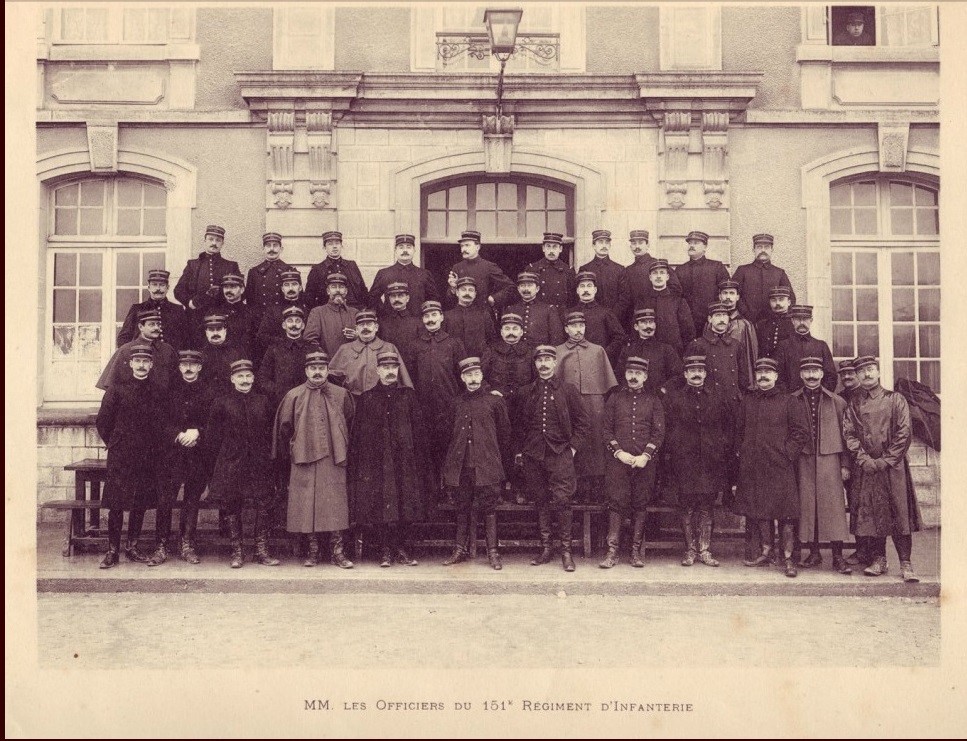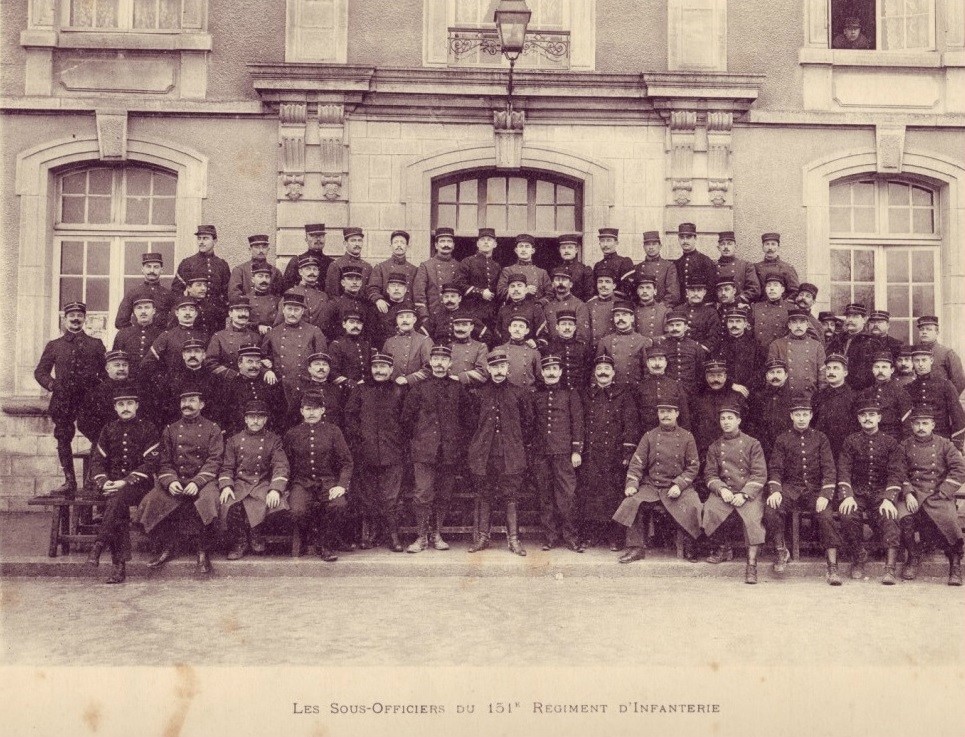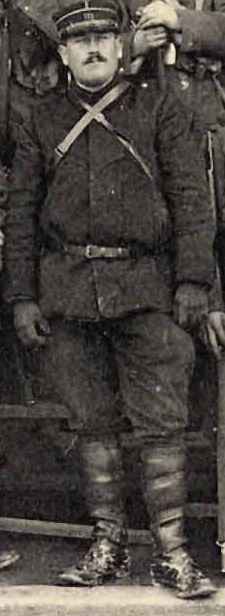Campaign History of the 151e Régiment d'Infanterie - I
Campaign History of the 151st R.I. - 1914-1918
~ 1914 ~
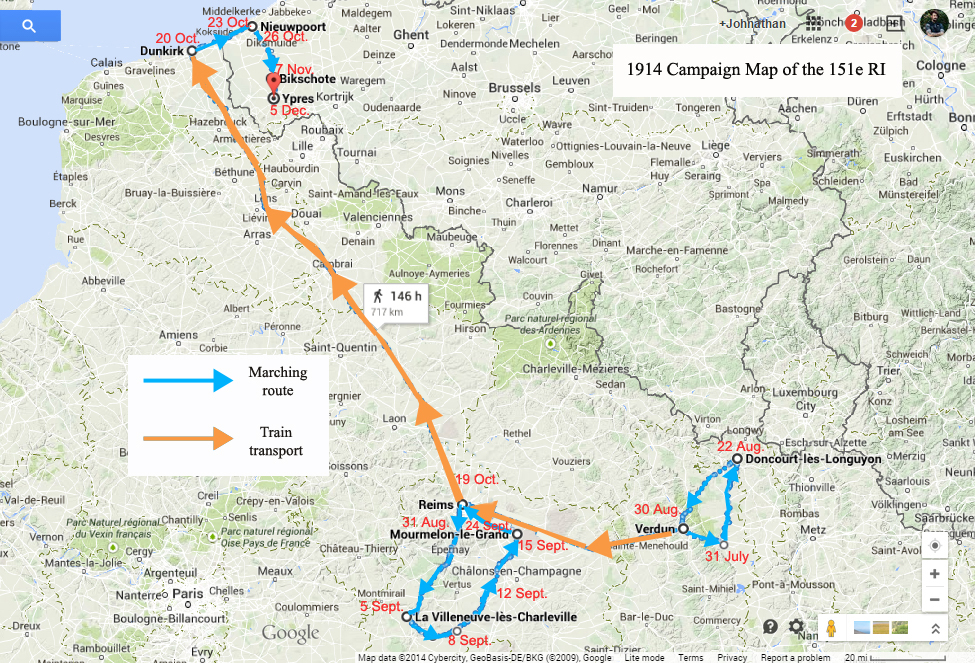
14 July: The 151 RI (along with the other units of the 42 DI), which had been conducting maneuvers at the Verdun training grounds in front of a nervous crowd of Meusians, prepares to depart for the Campe de Chalôns for its regular scheduled annual maneuvers.
28 July: While en route to Chalôns, the units of the 42 DI receive orders to proceed back to their garrisons. The 151 returns to the Miribel barracks at Verdun and places itself in a state of war-readiness.
31 July - 8 August: The regiment leaves Miribel and heads southeast towards the frontier (Lorraine) to help cover the border along with the rest of the 42 DI. One of those in the officer cadre is Gaston Joseph Tison. Born 29 October 1882 at Grandpré (Ardennes) Tison, class of 1902, possessed a baccalaureate in letters and mathematics. In October 1903 he was admitted into the Ecole Spéciale Militaire, being promoted to caporal a year later and sergent the year after that. In October 1905, he would be made a sous-lieutenant before receiving his assignment as a lieutenant to the 151 RI in October 1907. Tison would be later breveted as capitaine in October 1914 and made a full capitaine in February 1915. Tison was not just a writer but also an avid photographer, taking close to 300 photos with a personal camera until his death in September 1916. Out the outbreak of the war he was acting as a section leader of the 2e Section of Machine-Guns (2 SM, 2 Bat).
On 31 July 1914, Tison wrote in his diary:
The regiment is billeted at Pintheville, Marchéville and St. Hilaire, small villages on the Woëvre Plain directly between Sainte Menehould and Metz. It will remain for there for two weeks, as the men are put to work constructing defensive organizations. The following is the entry from the 151's JMO for 31 July 1914:So here we are more or less mobilized. For the eleven years I've worked, eleven years that I've heard spoken about or spoken of myself every day! Gradually the rumors of war grew, took shape, strengthened on implausible facts which eventually became true. Yesterday afternoon, there was much serious discussion about our covering [i.e., screening] movement. I had foreseen this possibility since the day when we were picked up on the road to Camp de Châlons at night to bring us back to Verdun and await events. I even bought this notebook to write down my impressions in case I left.My canteen is all set. I had gathered what little cash was immediately available with the idea of sending it to my people. My people -- those who occupy all my heart and for whom I would give everything, up to the last drop of my blood, until my last breath. Where are they at this painful hour. They were safe, relatively free from want. I was at ease on that account. My wife took into her the notion of coming back and jumping into this mad house, although I advised her against it. She did not listen to reason but to her heart, which told her to stick close to me with the whole family until the last moment.
Sous-Lieut. Tison writes in his diary:The regiment, leaving behind the officers of the 2nd platoon of the 351 RIR and the [151 RI] depot, puts itself in route for Fresnes-en-Woëvre at 0400 hrs, forming the A.G. [advance guard] of the 42nd Division.Between 1100 and 1300 hrs, the regiment breaks off to occupy its cover emplacements forming the Advance-Post of the 42nd Division, which the body is stationed at Fresnes-en-Woëvre - Marchéville - Bonzée. Emplacement of the A.P. Discretionary line: Pintheville - Riaville - Marchéville - St. Hilaire (from the Pintheville stream to that of Wadonville) [approx. 7 km front].
Advance-Posts:
-1 Bat. at Pintheville - Riaville (liaison with the 162 RI at Ville-en-Woëvre)
-2 Bat. and General Staff at Marchéville - St. Hilaire
-3 Bat. - Body of the A.P.- at Saulx-en-WoëvreThe liaison established by telephone from Marchéville to Fresnes-en-Woëvre at Riaville; by cyclists to Saul-en-Woëvre. The regiment [with] arrival of successive [convoys?] is provided with 4 days ration in the evening.
In the evening of 1 August, the regiment receives word that the general mobilization has been decreed, with the first day set for 2 August. The regiment is put to work constructing defensive entrenchments along its line of advance-posts.The next day we go to work. Are we going to start putting ourselves in position, conduct surveillance, build earthworks? Screening is pronounced. The reservists and especially the territorials, summoned under orders and coming through night and day, most of them happy, do their best to hide their fears and sorrows. The news keeps coming. The newspapers talk about everything except France.They’ve been really muzzled. As it should be. In the evening, another twist. The general mobilization is displayed and announced. The alarm is ringing out everywhere. The gendarmes drive around in cars. The troops on the borders have been ebbing since morning on. The horses are leaving too. The women cry. It’s a sad and unforgettable sight…
In Verdun there are 600 annexed people who want to get involved, others say even more. Some are claiming that Germany will give in. There are those who say that Germany will give back Alsace and Lorraine…It is said that France is holding its own and asking for compensation. We have to do something. Of course, once again we know absolutely nothing.
What is true, I believe, is that we’re working with an extraordinary concentration of force, that the transports are working overtime even before the mobilization and that there would be one or more terrible prepared blows. Everyone is full of confidence, we don’t see any hang ups. The general mobilization does not significantly delay our own and they are highly exposed. It’s a wonderful game. How’s it going to play out? Who will come out on top? Many claim they will give in. I believe it would be logical and civilized, but you have to be ready and unafraid.
The reservists are making a good show of themselves. The workers' centers are all worked up. "All right." I long to head out. We’re open to the most extraordinary news. It is better to analyze it all. We are fed up and would like a solution to this whole state of affairs. What damage has been done in poor Lorraine. There remains neither man nor cattle…I have been told that a 50 year old man enlisted for the duration of the war with 2 sons under the age of 28 and a nephew of the same age. No acts of cowardice are reported…
The regiment will remain in these positions, continuing to labor on their works until 8 August. All the while, false-news and rumors, often contradictory, fly about the ranks. A group of 150 Prussian Uhlans are said to be spotted in one village only to be disproved and then reported to be another. There are myriad rumors of border incidents, even of battles erupting and towns bombed, all later disproven or distorted, that the Germans had already marched through Luxembourg, that the English fleet was in Kiel, that Russia had attacked Germany, that Italy had split off from the Triple Entente, that Portugal had provided 100,000 men to Belgium, that Japan had made its fleet available to England, etc., etc. Lieut. Tison continues on in another letter:Trenches [to be dug] in front of Bois Communaux, Pintheville, Riaville, between the last point at Marchéville, in front of Marchéville and St. Hilaire. Heading in the general direction of Mars-la-Tour [due east] and all the ground between the Butgnéville stream to the north and the St. Hilaire - Tronville line to the south.
Officer cadre of the 151 RI as of 5 August 1914. (Excel version)We’re still working all day in the wet oats. I catch a bad cold from it. Still no news, only false rumors. The big one is declaration of war. Lots of emotions. But it was denied soon after. Rumors of border incidents, even of battles: Longwy bombed, the entry of the Germans through Luxembourg, all that and all disproven later. It is claimed that the English fleet is in Kiel, that Russia begins hostilities, that Italy is detached from the Triple Alliance, that Portugal provides 100,000 men to Belgium, that Japan makes its fleet available to England etc… It is said that there was a German patrol gunned down in Longwy (?), or in Longuyon, an engagement between chasseurs à pied and uhlans took place, that we suffered two wounded and 60 killed or injured on their side. It is said that 150 Uhlans were taken prisoner at Mars la Tour, that we have a motorcyclist-spy corporal. It is also said that the Germans are retreating from their covering screen from 8 to 10 kilometers. It’s announced that an ultimatum has been given to the Triple Entente for a German demobilization. We don't know anything.
. . .
Food won’t be lacking either. Everything is requisitioned before us. One could not calculate the herds and groups of horses which have been sent back to the rear. Moreover, there is nothing left in the villages -- there’s nothing left to buy up. Saw my first 5 Franc and 20 Franc banknotes. At 9 in the evening the 2nd echelon arrived. They were totally exhausted. Some men have traveled for miles without eating. I take care of mine. I make sure they eat and sleep.
. . .
People bring us news. Everything is going very well with surprising speed. There is false information too. The only one truth is the assassination of [Jean] Jaurès. He had changed his mind in the end. General Pau would be minister to replace the resigned Messimy. I go to bed fully dressed because we truly don’t know what’s coming.
Maps from the 151 RI JMO showing, from left to right: Pintheville-Riaville-Marchéville-St. Hilaire sector; position of advance-posts of the 2 Bat/151 RI at Marchéville and St. Hilaire; advance-posts of the 1 Bat/151 RI at Riaville and directions of fire; defensive works executed by the 3 Bat/151 RI with general directions of fire (blue = 1st line, red = fall-back positions); defensive works constructed around Pintheville and the Bois Communaux.
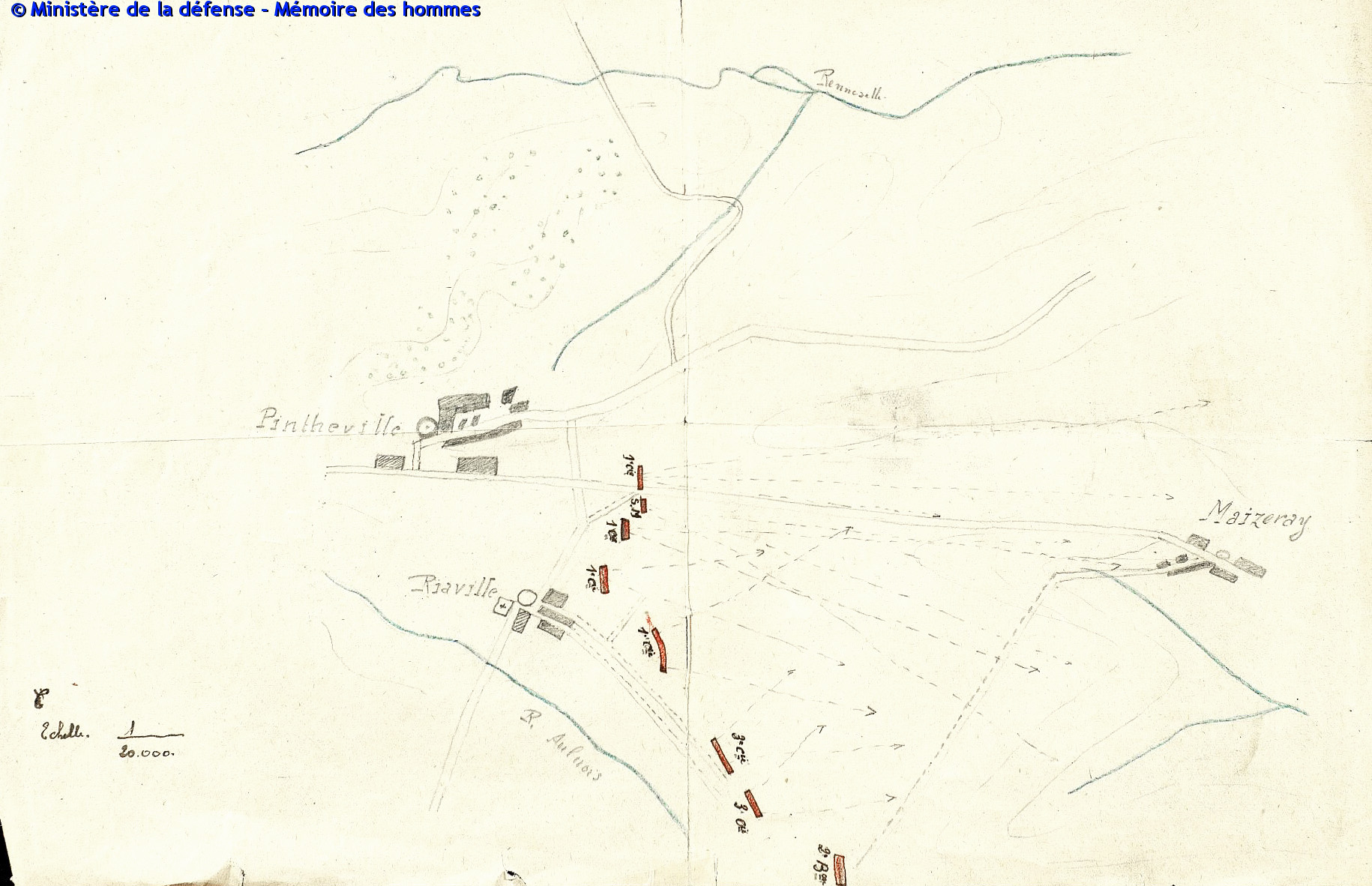
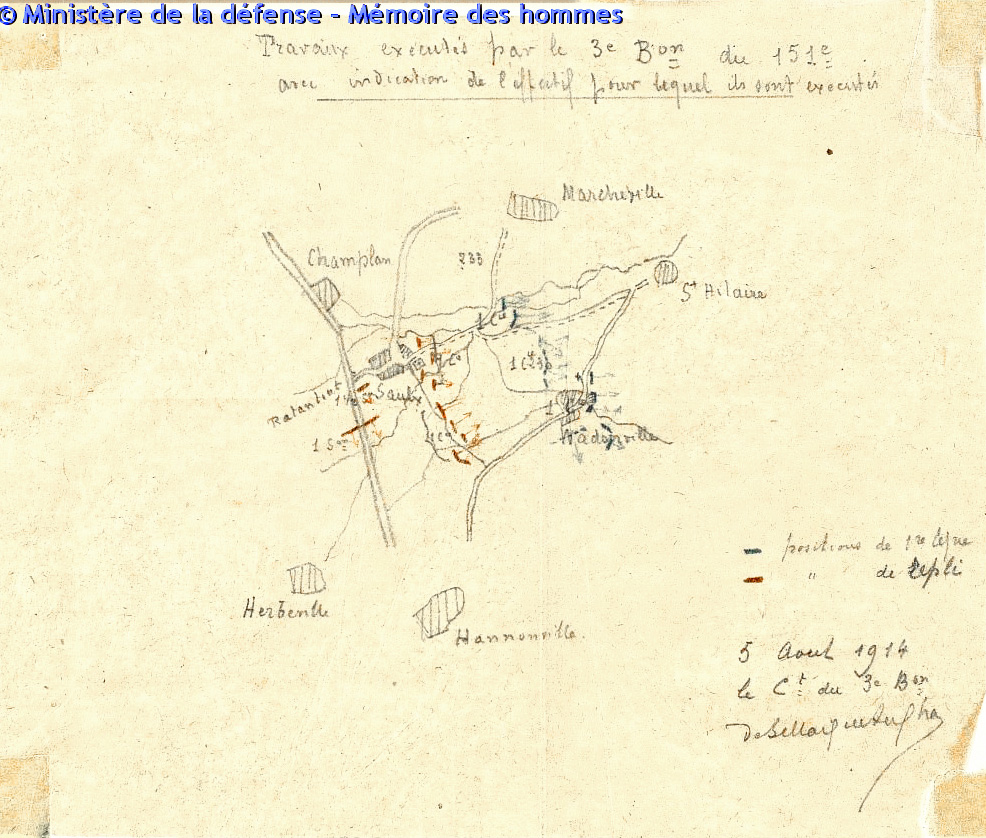
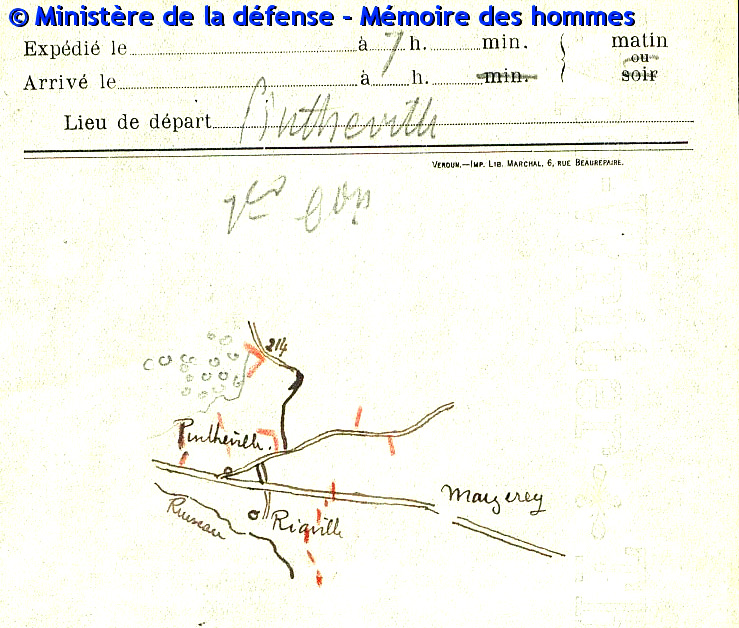
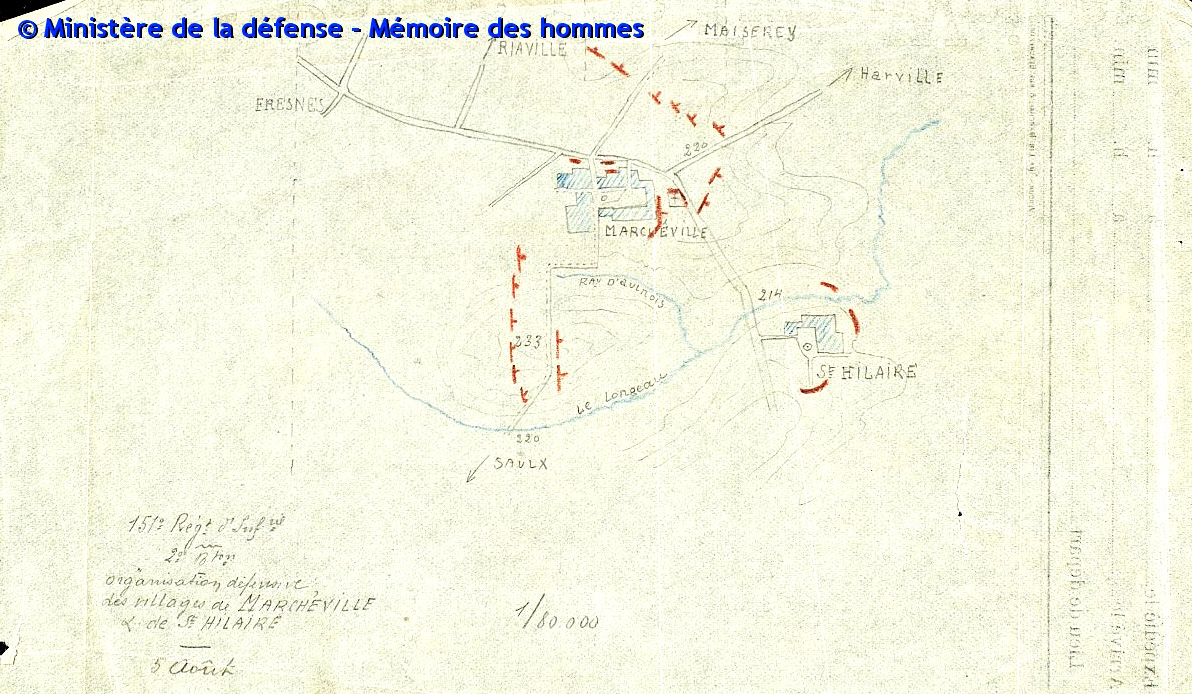
Battle of the Frontiers
9-13 August: Orders arrived from brigade at 1150 hrs stating that a cavalry engagement in area of Spincourt had broken out. The 3 Bat. of the regiment billeted at Saulx-en-Woëvre was to move immediately to Etain with the objective of covering the front of Rouvires - Ferme Longeau along with the 8 BCP and other formations. On the morning of Sunday 9 August
On 10 August, 3 Bat. arrives at 1800 hrs at Etain with no contact made with the enemy. Two days later, the 3 Bat. rejoins the rest of the regiment at Riaville. The companies of the regiment continue to be maneuvered to block enemy movements but real and imaginary but still with no contact made. All the same, on 13 August, Lieut. Tison reports a moment of excitement:What a deep impression. A soldier says mass while being served by other soldiers. Soldiers fill the small church which has certainly never seen such officiants. Here and there, a few women dressed in black are crying and it is with stirring emotion that we listen to the soldier-priest who invites hearts to exalt in the knowledge that God who has never abandoned France in her hours of need. Does he speak the truth?! In any case, what is certain is that all of us here will do our duty. We [officers] wish we had no one to think of, no thoughts of family to distract us, so that we could devote ourselves entirely to this noble task: to expel the invader! But no, that's not really true. It's good that we have to make a sacrifice as great as that of our men and act as an example of courage, of complete abnegation. That like them, and even more so, we suffered and gave up things too. God be with us!
This morning, I had a slight baptism of fire...A German monoplane appeared before our advanced-posts. I was setting up our guns in battery and looked at it through some binoculars. At that moment gunfire erupted on all sides and I saw that I was in the middle of the bullets path. I had all the trouble in the world gathering my men under shelter in a hole. Bullets could be heard whistling by. We then fired 2 cannon shots at it. There is a rumor this evening that the 40th has destroyed it. We'll find out tomorrow. Planes are lack and will be employed later. As for the French army absolute secrecy is maintained, even for us.
14 August: With the advance of the German 5th Army into France through the Ardennes forest, the 42 DI is sent to check the advance. Orders arrive from division that the 6 CA will move north to the line of Braques - Doncourt - St. Benoit. At 0400 hrs the 2 Bat. sets off, along with the general-staff, regimental train and combat train.
16 August: 2 and 3 Bat. march north and are put to work constructing defensive entrenchments. The 2 Bat. is billeted at Ville-en-Woëvre and the 3rd at Hennemont. The 1 Bat. remains at Pintheville. The battalions will continue to work and serve in the advance-posts for several days in the villages of Ville-en-Woëvre, Hennemont, Olley, and Parfondrupt.
17 August: The 84 BI cautiously moves northeast in two columns, with the 151 RI at the head of its column, followed by the 29th group of the 61 RA (Regiment Artillery), a company of engineers, and the 42 DI headquarters. The regiment establishes APs on the line of Mouaville to the Bois St. Jean to Ferme de Neuvron, and reconnaissance patrols are sent out to scout the ground ahead. The next day the regiment entrenches in place and a line of resistance is organized from Mouaville to Olley. Lieut. Tison relates a humorous anectdote from his time at Olley. Writing on 19 August:
Map of the Battle of the Frontiers, August 1914.Yesterday, outpost day. I spent the night in a hut made oats, after spending all day making a trench. In the morning, we had gone over the terrain. I had ridden a scout's horse to carry it out. She was a requisitioned brood mare who had never worked a field, as wide as a table, as massive as an elephant. She doesn't understand a thing. She stopped at the exit of Saint-Jean de Buzy and wouldn't budge. I broke 2 cudgels on her back trying to get her to move and I would still be there if it hadn't been for 4 scouts that she kindly followed to Olley. Fifty meters from the assembly point, she started again. I gave her 2 cudgels before finally dismounting and proceeding on foot the rest of the way. I developed a real soreness afterwards and at first wondered what caused it. I wonder what...
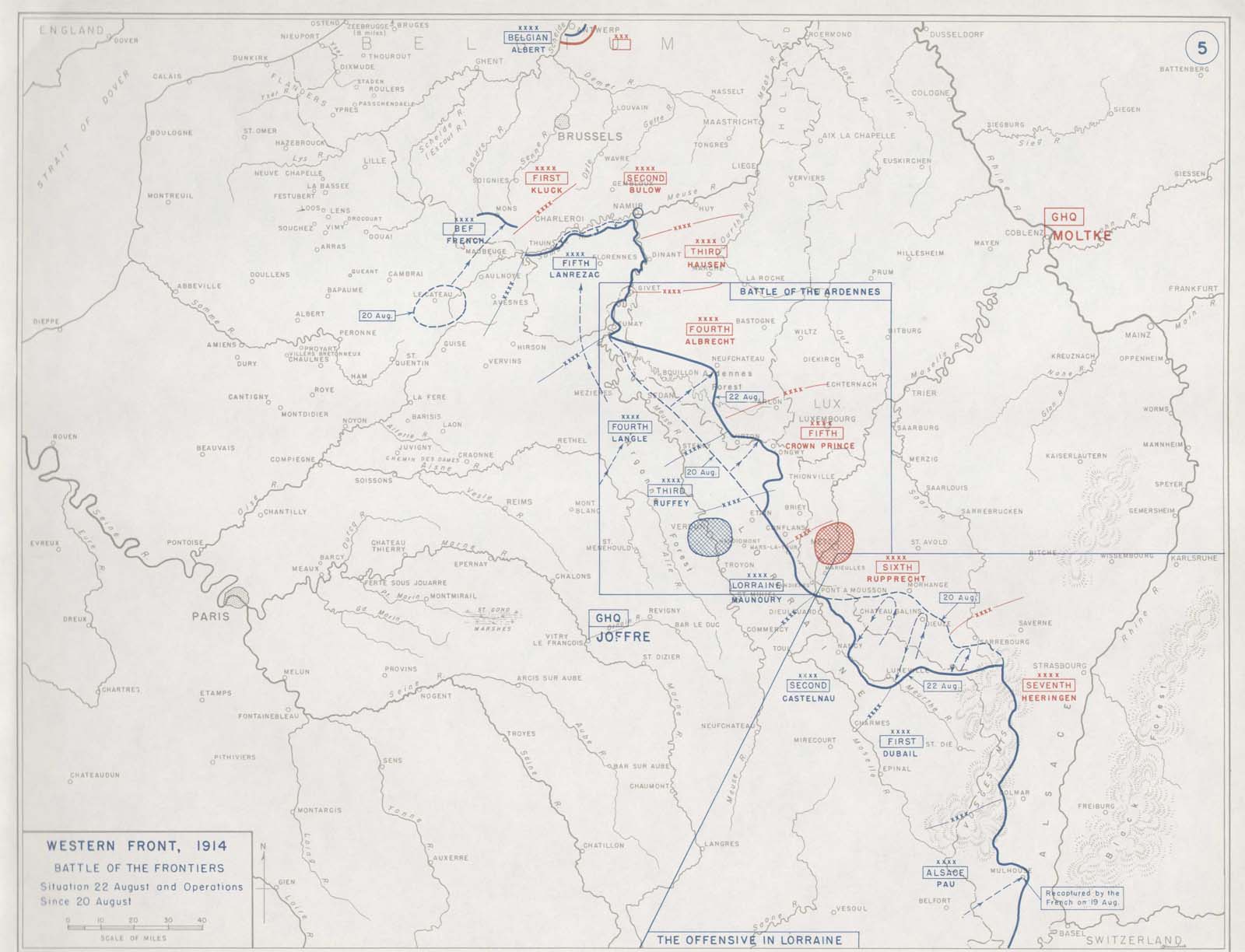
21 August: 42 DI is ordered to march north to Mercy-le-Bas via Gondrecourt[-Aix], Affléville, Joudreville, Domprix, and Xivry-Circourt, with the 12 DI marching in the same direction in echelon to the left and forward of the 42 DI. The 151 RI forms the head of the column in the order of 3, 1 and then 2 Bat., flanking two groups of the divisional artillery. As the 3 Bat. passes Gondrecourt, the regiment receives word that enemy forces have been spotted in Joudreville, Bois La Proie [Proye], and Piennes. The regiment is ordered to send a battalion to attack these locations, supported by divisional artillery stationed on Côte 301 (1500 m southwest of Narroy-le-Sec). 3 Bat. is given the order to attack, with the 1 Bat. being ordered to advance to Affléville to support the 3 Bat.’s attack. The regiment begins its advance at 1125 hrs with the following routes: 3 Bat. via the Bois le Proie and Piennes, 1 Bat. on the Joudreville Road, 2 Bat. 500 m east of Joudreville Road.
By 1500 hrs, the 84 BI arrives at Domprix via Mertametz (sp?) and halts, facing to the northeast at 1600 hrs. The 151 RI is ordered to take Moulin-le-Haut (entering to the southeast of Xivry-Circourt) via Higny where the 19 BCP was engaged with an enemy force holding the woods of Côte 349 (800 m north of Higny). The regiment departs Domprix with the 1 Bat. deploying forward and the 2 and 3rd in echelon to the left and right, respectively. At Xivry-Circourt, Colonel Deville receives an order from the general commanding the AG, which stated:
Colonel Deville directs the 3 Bat. toward Higny in order to attack the woods in question, coordinating its action with the 19 BCP, to look to push the enemy back to Boudrezy and occupy this point. The 1 Bat. in liaison with the 3rd takes the direction of the western edge of the woods. The 2 Bat. makes itself available to the south of Xivry. Colonel Deville moves to Higny.The enemy seems to be making an effort towards Higny where he is fighting the 19th Bat. of Chasseurs. Move up to Higny and together with the 19th Chasseurs, look to repulse to the east and to the north of the woods (800 m north of Higny). The 94 RI marches by the north via Ferme "Le Chanois".
At 1820 hrs, contact is made with the 19 BCP, which reforms behind Higny after having repulsed the enemy and suffering significant losses in doing so. The 151 RI falls back to Xivry-Circourt and from there to Domprix where it is billeted. The 84 BI is told to be ready to depart at 0400 hrs the next day.
Map of the regiment's movements can be found here.
Battle of Pierrepont/Baslieux
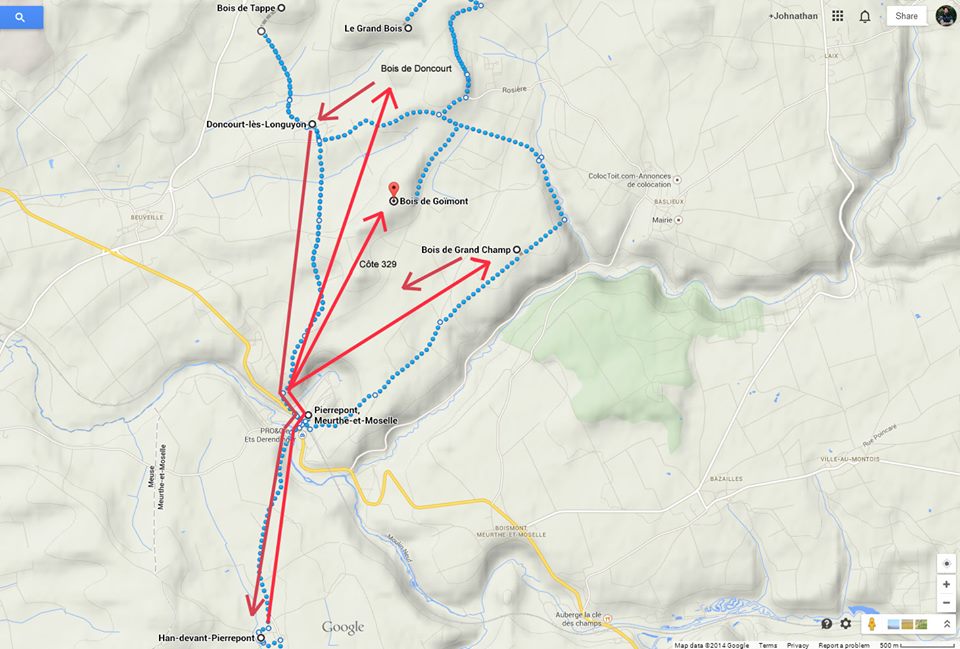
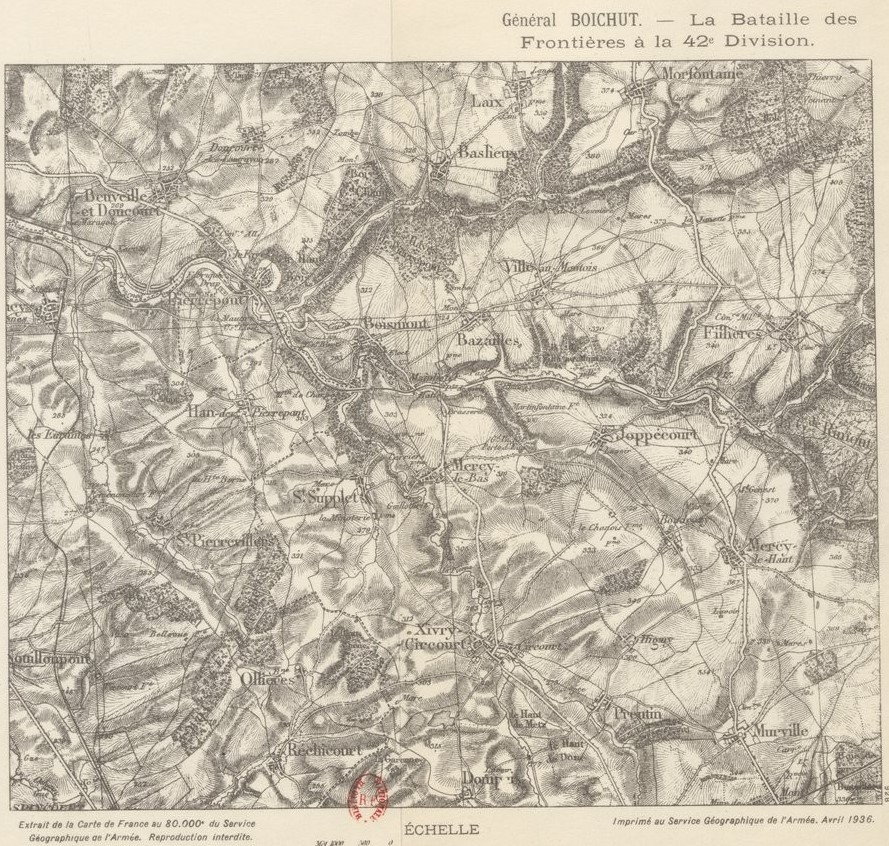

Left: Map showing general movements of the 151 RI on 22 August 1914. Center: Battle of Pierrepont map (source: http://gallica.bnf.fr). Right: sketch of 42 DI deployment on 22 August 1914 by Cpl. Alphonse Goubert (7 Co., 151 RI) (Courtesy of Gerard Schutz).
22 August: 42 DI moves in column along the front of Mexy – Villers-la-Montagne with the majority of its forces on the right. It is to advance in the following order: Saint-Supplet – Han-devant-Pierrepont – Doncourt. The advance guard is provided by the 151 RI, the company of engineers, the group of artillery and a divisional cavalry squadron.
The regiment moves to the P.I. [Point Initial, “starting point”] (Saint-Supplet Church) at 0530 hrs in the order of 1st, 2nd, and 3 Bats. According the JMO, a flank-guard composed of the 2 Co. and No. 2 section of machine-guns is sent out on the right via Mercy-le-Bas, the eastern edge of the Bois Grandchamp, and Côte 320 to the north of this woods. Somewhat conflicting this is Colonel Deville’s report for the actions on 22 August, which notes that two companies of the 2 Bat. provided the flank-guard. Intelligence on the enemy is provided by an officer of the general-staff at Saint-Supplet. Intelligence from the cavalry (10e Chasseurs à Cheval). Despite having patrols as far as the Bois de Doncourt, the cavalry reported back to the general commanding the 42 DI that no enemy force had been detected within a radius of 10 km from the march route. This poor intelligence would soon prove disastrous for the division.
The advance-guard crosses the Crusnes River via the Pierrepont bridge and the head of its body stops at 0800 hrs at the top of Côte 329 (1 km south of Doncourt) for an hourly halt. The 2 Co. forming the head of the advance-guard, stops at the entrance to Doncourt. Colonel Deville (commanding 151 RI) establishes his command at the top of Côte 329. In contradiction of the cavalry's intelligence, while 2 Co. is at a halt, Deville at 329 spots an enemy movement 1 km north of Doncourt, in the gap between the Bois de Tappe and Bois de Doncourt, moving from west to east, and reports back to division "German infantry marching in column of fours on Route 320 to Doncourt." Suddenly the 2 Bat. (6 and 7 Cos.) comes under fire from German artillery batteries located on Lartimont Ridge and infantry in position in Bois de Doncourt.
Colonel Deville reports this to the commander in charge of the advance-guard and then sent the following orders to his various battalion commanders:
These orders are immediately carried out, however this meant they were advancing without the support of the divisional artillery. The charging companies immediately come under a veritable storm of shrapnel fire from the German field artillery positioned near Bois de Goëmont and Bois de Grandchamp. The troops manage to reach the woods but are forced to take cover in the face of the devastating artillery fire, which was inflicting heavy losses in the regiment's ranks. At 0900hrs, 7 Co. launches a sortie in the direction of Bois de Doncourt, reaching the objective and setting up position in the wood but takes heavy losses in doing so. Meanwhile, 6 Co. makes an advance into Bois de Grandchamp, suffering many casualties as it does. Encouraging their men under fire, the officers offer themselves as conspicuous target. With the officer cadre decimated, the order is given to fall back to Doncourt.0810 hrs - to 1 Bat.:
Occupy the Bois de Tappe and the Grand Bois de Doncourt [1 and 2 Cos., with 3 and 4 Cos. left in reserve at Côte 329] and don’t move from there without orders. The 2 Bat. (right flank-guard) will arrive later alongside you to the east of the Bois de Doncourt. For the moment, I’m at Côte 329 on the Pierrepont - Doncourt Road.0820 – to 3 Bat.:
Move immediately up to the eastern edge of the Bois de Goëmont [Goïmont] (southeast of Doncourt), which is occupied by enemy infantry. Inform the 2 Bat. of your action, which will arrive near this woods.0840 hrs to 2 Bat.:
Occupy without delay the Bois de Goëmont [with two companies]. Enemy infantry is likely occupying it. I sent the 3 Bat. to strengthen your right.
Left: Doncourt before the war. Right: Doncourt in 1915.
At 0915 hrs, the Germans make a push forward but their counter-attack is broken once it reaches the French lines of defense, supported by the 61 RAD. (Regiment d’Artillerie Divisionaire). The Germans fall back to the woods of Baslieux, Pierrepont, Tape and Doncourt. At 0945 hrs a battery is finally put into position near Côte 329 and opens up in support of the regiment. Colonel Deville positions himself on Côte 324 to observe the action unfold. Soon, the last of his units disappears from view except for 3 and 4 Cos., which were deployed in reserve at Côte 329 facing Doncourt.
They were advancing without the support of the divisional artillery. The charging companies immediately come under a veritable storm of shrapnel fire from the German field artillery positioned near Bois de Goëmont and Bois de Grandchamp. The troops manage to reach the woods but are forced to take cover in the face of the devastating artillery fire, which was inflicting heavy losses in the regiment's ranks...The whole world is erupting, as the snapping and whistling of bullets mixes with the bursting shells and whizzing shrapnel balls. The regiment fights on bravely all afternoon in the woods from Doncourt up to Grandchamp, attempting to take to the offensive. Everything is chaos, noise, smoke, fire, blood. The whole world is erupting, as the snapping and whistling of bullets mixes with the bursting shells and whizzing shrapnel balls. The regiment fights on bravely all afternoon in the woods from Doncourt up to Grandchamp, attempting to take to the offensive. Everything is chaos, noise, smoke, fire, blood. During the fighting, the 3 Bat. will join the 162 RI which veers off to the east to engage the enemy in the Bois de Grandchamp. After sustaining heavy losses, the companies of the 2 Bat. falls back in disorder to Doncourt and join up with the 1 and 2 Cos. of the 1 Bat. In Doncourt they barricade themselves in and liaison with units of the 12 DI, which had attacked Bois de Tappes to the northwest. Towards the end of the day, despite a violent fire from both field and heavy artillery, the regiment continues to hold the line of Doncourt, Côte 329, and the southern border of the Bois de Grandchamp. The men hugging the ground, throw the packs in front of themselves and dig small rifle positions in a desperate attempt to escape the steel raining down around them.
Sensing the weakening of the French defense, the Germans launch another counter-attack. The 8 Co. of the 151 is annihilated in the attack. But the machine-guns of the neighboring 25 BCP and the 162 RI inflict heavy casualties on the German assault waves and repulse the counter-attack. At 1730 hrs the fighting begins to wind down. At 1800 hrs, a final order is given, "les enfants, baïonette au canon" ("fix bayonets, boys"), in payment of respect to its dead.
At 2000 hrs, it receives the order to break off contact under the cover of darkness, cross back over the Crusne using the Pierrepont bridge, and set up in bivouac to the north of Han-devant-Pierrepont. The movement is executed in good order through Bois Fayel (1 km southwest of Côte 329, the northwestern edge of Pierrepont) around 2330 hrs. The 1 and 3 Bats. are billeted at Han-devant-Pierrepont except for one company assigned to man the advance-post to the south of Pierrepont. The 2 Bat., which had not been able to reassemble upon exiting the fight, was poorly directed on its way to bivouac and ended up near Arrancy (4 km to the northeast) at 2330 hrs. It would rejoin the regiment the next morning at 0400 hrs.
Read the last letter of 2nd Lieutenant George Le Balle, killed on 22 August 1914 here.
23-24 August: 84 BI moves to the rear heading south via the Haute-Borue, Saint-Pierrevillers, Nouillonpont. The 151 bivouacs in the evening in the sector of the Ferme de Haudeville (east of Pillon) and the northeast corner of the Bois de Warpremont (Warphemont). The 1 Bat. occupies the advance-post at Rouvrois facing to the northeast. The following day, 24 August, the regiment is under arms at 0400 hrs occupying the same emplacements. At 1115 hrs, the 84 BI DI is ordered to make preparations for a counter-attack in the direction of Saint-Pierrevilliers by way of Duzey. The 16 BCP departing from Nouillonpont would attack Saint-Pierrevilliers directly and ensure the liaison the 83 BI. The 162 RI would attack in the direction of the Saint-Pierrevilliers train station and cut 500 m north with a battalion from Rouvrois to Rivironcourt at with a battalion from Duzey. The 3 Bat/162 RI would be at the disposition of the brigade commander following the line of Rouvrois - Saint-Pierrevilliers.
The 151 RI would leave the 1 Bat. in garrison at the strong point of Rouvrois. The other two battalions were at the disposal of the brigade commander to the west of Duzey. The 1 Bat. assembled outside of Rouvrois to the southeast near the road, concealed behind woods, while the 2 and 3 Bats. sheltered from view behind the walls of Duzey. The attack by the one battalion of the 162 RI towards Saint-Pierrevilliers progressed rapidly and the 3 Bat/151 RI was ordered to advance in a wide formation of half sections by two to the east of the Othain, between the river and astride the street linking Duzey to the main road. This was just completed when there was a perceptible recoil in the lines of the battalion of the 162 RI brought on by heavy losses inflicted to the east of the railroad embankment by the first line of enemy skirmishers, immediately accompanied by an intense fire from several enemy heavy artillery batteries placed in all likelihood on the Haute.
Orders are immediately issued to the 2 and 3 Bats of the 151 RI to take up positions on the crests to the northwest and southeast of Duzey in order to repulse any enemy infantry attack and retake the movement of the battalion of the 162 RI. According to Colonel Deville’s report for the day, the 2 Bat. was now reduced to only two companies, noting that the 1 Co. was in support of artillery and the 3 Co. ceased to exist on 22 August. This note is confusing as the 1 and 3 Cos. Would have been in the 1 Bat. Regardless, the companies of the 2 Bat., being sheltered by the walls of the enclosures and homes, were able to quickly install themselves on the crest to the northwest of Duzey. The same is not true of the 3 Bat., which must carry out its movement under the intense fire of the heavy guns. Elongating its fire, the enemy artillery overwhelms Duzey and opens up on the the surrounding area to the rear. The companies of the 3 Bat., though maintaining a regular march in small columns of sections by four, must retrograde up to the edge of the Bois de Warpremont where Battalion Leader (de Bellaigue) de Bughas leads them to the positions occupied that morning. Pinned down by the fire from machine-guns posted to the east of the railroad embankment, the battalion of the 162 RI in unable to resume the attack.
As such, the 151 is ordered to reform on its positions from the morning, then to reassemble between Pillon and the north corner of the Bois de Warpremont. The movement is completed by the 1 and 3 Bats. around 2000 hrs. Meanwhile, at 1900 hrs the 2 Bat. leaves its positions on the crest that it had occupied since 1600 hrs to the northwest of Duzey. It heads off in the direction of Mangiennes (due west), to which it was mistakenly informed was set as the rallying point for the regiment. At 2100 hrs, the 1 Bat. is ordered to reoccupy Rouvrois and to barricade itself in for the night. The 3 Bat. would bivouac at the northwest corner of the Bois de Warpremont.
One of those wounded this day was Lieut. Tison, who was hit in the leg by a small shell-fragment but continued to command his machine-guns. The next day he would write:
Not had the time to write anything down. Fighting without stop, the rest of the time moving to the advanced-posts. And the cannon has not stopped thundering since the 21st. On the 1st day (21 August) we went to block off Longwy. We were on the flank. Caught by surprise [by the enemy], fired 150 rounds. Retreat through the woods, artillery fire, got lost. Bumped into General [Grossetti] in Pierrepont with just one gun and no horses, [my unit was] last seen in this village. Impossible to find them. My men carried the gun by themselves for 7 hours. All attempts to join the regiment unsuccessful...with the medical service now.The next day (22nd) finally rejoin the regiment at Pillon. A day after that (24th), fighting at Duzey, Arrancy. Wounded in the lef, Impossible to walk. Carried by a medic then put in a medical car. Light wound from shrapnel balls. Dropped off at Mangiennes. The day after, evacuated hurriedly and against my will to the train station at Azannes. I wanted to go back to the regiment, but I could hardly do so, my leg aching and feeling heavy despite only having a scratch (pain in...?) and bruises. They put me on the train. I reached Verdun, where I managed to get stuck in the depot for the crippled so I could rejoin the regiment as soon as possible.
25 August: At 0400 hrs, the 1 and 3 Bats. are sent again occupy the trenches dug on the eastern edge of the Bois de Warpremont between Côte 251 and the Ferme de Haudeville. The 2 Bat. rejoins the rest of the regiment before being sent forward of the Ferme de Haudeville in order to surveille the openings to Rouvrois. Immediately after the battalion installs itself in the advance posts west of Rouvrois it is attacked by a superior enemy force (infantry and artillery). All morning long the regiment fights off infantry attacks coming from the direction of Nouillonpont and Duzey, while under fire from the enemy's heavy artillery. A battery of 120s goes into position to the west of the Bois de Warpremont, near Côte 227, and opens up a successful counter-battery fire on the German batteries. The companies of the 3 Bat. hold up in their positions against a concentrated enemy fire.
Later in the day, the commanding officers of the 151 observe columns of the 40 DI moving in the direction of Pillon and Arranc, seemingly falling back to the southwest. A staff-officer of the 24 BI informs Colonel Deville that the 40 DI had received orders to conduct a fighting retreat. Concerned about the security of his left flank, Colonel Deville requests orders from his brigade commander and continues to hold fast in his positions. During the wait, the first from the German heavy artillery slammed into the trees of the woods in such a way that the position soon became untenable. Consequently, Colonel Deville made the decision to rally his battalions while he still has time. He orders the 3 Bat. to conduct a fighting retreat by echelons to the Bois Saint-Médard (south of Pillon) about 5 km away. The movement is conducted calmly and methodically. The 2 Bat. follows the 3rd, which is then followed by the 1 Bat. The 1 Co. (commanded by Capt. Chamaillard) was the last company on the wood line to remain in position and as such, was subjected the longest to the German infantry attacks. The losses in the German ranks grew heavier as they neared closer to the French positions. By putting up this resistance, the 1 Co. bought time to allow for the evacuation of the wounded.
The regiment reorganizes and takes up position on Côte 267 (1 km southwest of Pillon) astride the Arrancy Road. Brigade at last orders the regiment to retreat to Azannes via Mangiennes. To the north of Azannes, around 1800 hrs, the 84 BI bivouacs between the village and the Ferme de Mont Aubé. The regiment occupies the Bois de Mont Aubé, having a battalion of chasseurs á pied on the line of Côte 240 – Bois Bochet.
The regiment's total effective is now reduced to 2,317 officers and men.
Officer cadre of the 151 RI showing losses as of 26 August 1914 can be found here.
26 August:The regiment leaves its bivouac at Mont Aubé at 0730 hrs and moves to Ville-devant-Chaumont, where it takes up billets in an alert status (cantonment d’alerte). The 42 DI receives orders to continue its retreat towards the Meuse and the 151 RI departs Ville-devant-Chaumont at 1300 hrs. At 1700 hrs, the Meuse is crossed using the Bras – Charny bridge. The regiment is billeted for the evening at Béthlainville completing in one day a retreat of roughly 45 km (28 mi). The following day the 42 DI is placed in reserve and tasked with the defending the Meuse line.
27 August: The regiment is ordered to march to Cheppy. Departing Béthlainville at 1100 hrs it halts for the evening at 1800 hrs near Varennes (19 km march), with the 3 Bat. billeted at Cheppy, and the 1 and 2 Bats. with the general-staff at Véry (3 km north of Cheppy).
28 August:The regiment receives what will be its first of many replacement troops. It is a detachment of reinforcements coming from the depot at St. Quentin (depot of the 351 RI, the 151's reserve regiment), commanded by Battalion Leader Commandant Monphous and comprised of 9 officers and 927 reservists.
On the same day, Lieut. Tison records:
Spent a day in Verdun. I find some lost machine-gunners there. I intended to rejoin the regiment immediately. Unfortunately, the crippled are taken together to Bar-le-Duc. I arrive there, 1313 men from various units, with a comrade more badly wounded than me. Difficult task. They put me in the hospital. I peeled off while walking. It's nothing really, but I get impatient and annoyed. And then I am in the hands of doctors who will not let me go until whenever they chose. I am told 1 or 2 days. We'll see, but hopefully quickly.So far, I have just noted the facts of the matter, not my feelings, which are too personal and are painful for me. I can't wait to get back into combat and am regretting what really is only a sore spot has been called an injury. The ball I was struck by now seems only like a blow from a hammer. In the ambulance, we were stripped of all equipment, so I had to be re-equipped. Fortunately I found some good comrades at depot 166. I hear the names of the wounded. Cpl. Jacquot killed, Le Bihan seriously injured, Cpl. Populus hit in the leg, Cmdt. Destival wounded, with me Capt. Coltat, Lehoux (bullet in the arm).
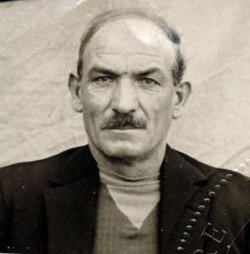
Sdt Jules Caron in 1930.
One of those replacement troops was 25 year old Sdt. Jules Caron, who had arrived on 3 August 1914 at the relocated 151 depot at Saint Quentin. He wrote:
The companies of the regiment, having suffered heavy losses in the fighting on the 22nd, 24th and 25th, are reconstituted by means of these replacements. In the afternoon, the regiment is advised to be ready to embark Cheppy and Véry to board trains at Verdun.They give us poorly fitted equipment, oppressive, burdensome, all shiny, noisy, uncomfortable. A distribution comprising:
a backpack to carry things; camping items and personal effects such as shirts, side cap, sewing kit, razor, soldier’s booklet; reserve rations: two hardtack biscuits, two cans of meat, soup, two rations of sugar and coffee. a rolled up blanket and a 1-liter canteen. a uniform comprising: the renowned madder red pants, a greatcoat, a navy blue kepi, not to mention the bayonet and the "Lebel" rifle.
Altogether it weighs thirty kilos.
Thanks to the arrival of the reservists, the regiment's total effective is boosted to 3,250 officers and men. The other regiments in the 42e DI had likewise received reinforcements. However, these were older than those reservists received on 2 August and they were inexperienced troops who'd not yet seen combat. Arguably it could be said that the injection of these men into the ranks diminished the overall division's fighting effectiveness. This was particularly true in respects to the 2e Bat., which had suffered the heaviest losses on 22 August, losing almost all its officers and three-quarters of its NCOs. From the reinforcements of the 351e RIR, it received 4 reserve sous-lieutenants, 28 NCOs, 30 caporaux, and 350 men. In addition, thanks to transfers within the Corps on the same date, it received a number of active officers from the other two battalions, so that each of its companies was commanded by an active officer. The 2e Bat., reconstituted with untrained reservists -- half of whom were in the composition of the companies they barely knew -- may only be of limited combative value in the immediate days ahead.
Thus, it could be said that the 42e DI which embarked from Verdun again on 29-30 August bore only a distant resemblance to the one which left its barracks just a month ago. There was also the matter of the physical state of the units. On 30 August, the 151's Chief Medical Officer, 1e Classe, sent the following report to the Colonel:
29-31 August: After 48 hours rest, the regiment marches in the afternoon past Avocourt, Béthlainville, and Thierville, arriving at Verdun at 0100 hrs on 30 August. Soon after, the battalions were boarded onto three trains (in fact, poorly equipped cattle cars) and heading off in the direction of Reims, arriving on 31 August and billeting at Courcy and Loivre. The 42 DI, now under the command of General Grossetti, is detached from the 6 CA in order to operate to the left of the 9 CA and is given the objective of protecting the withdrawing elements of the IV Army in the area south of Rethel at the Retourne River. The 42 DI it is told to establish an advance-guard in the region of Sault-Saint-Remy - L’Ecaille - Bazancourt, with the 151 RI specifically at Boult-sur-Suippes. The 1 and 3 Bats. go into line at Ferme de l’Esperance (4.5 km northeast of Boult-sur-Suippe) while the 2 Bat. looks into the defense of Boult-sur-Suippes (north bank) and that of the northern edge of the woods between the Retourne and Suippes near points 91 – 103 and to the east.During the marches, many men stopped with tired hearts. Reinforced by 1,000 untrained men, after four days of fighting, the Regiment had to complete a 40 km stage (Cheppy-Verdun), followed by rail transport, which was no real rest. Combat days were separated by bivouacs without straw; marches took place at night; all this weakened the 151st's physical resistance and potential.
1 September: The 151 is given the mission of defending the passage of the Retourne at Ferme de l’Esperance by delaying the progress of the enemy only and fighting in retreat if pressed. In the morning the 2 Bat. is sent to the north of Bazancourt. The lines of retreat are marked for the 3 Bat. as l'Ecaille via Isles-sur-Suippes, for 1 Bat. via Saint-Remy-le-Petit and Warmériville. Around 1600 hrs, first contact with the enemy is made by the 1 Bat. and supporting artillery batteries, whose well-regulated fire allows for an orderly fighting withdrawal. Sdt. Jules CARON, in 3 Co., 1 Bat. recorded:
The 3 Bat. is not engaged but conducts its withdrawal as well. The 1 and 3 Bats. are billeted at Fresne as the 2 Bat. falls back and takes up the advance-posts north of town to cover the retreat of the 1 and 3rd.The soldiers assemble, cartridges were distributed, the enemy was spotted at Avançon near Rethel (Ardennes). Confrontation with the Germans is near. The 151st Infantry Regiment marches all morning. We arrive close to the fighting. The cannon fire is getting stronger. We pass through woods, villages with deserted homes. Around 1700 hrs, the battalion was attacked by a German artillery battery. The shells rained down on the men. The din was deafening, the explosions made the body vibrate.We take shelter as best we can, clutching our rifle, jumping with the explosion of each shell, suffocated by the smoke they produced. The order to fall back is given, we are retreating to Fresnes Les Reims cantonment for the night.
2-4 September: The regiment shifts slightly as the 2 and 3 Bats. move to Courcy and the 1 Bat. to the Verrerie from Neuvillette for rest. The advance-post established on the line of forts from Reims made by the 162 RI to Bourgogne and Brimont, in liaison with the V Army to the Fort St. Thierry. The 16 BCP is at Courcelles-les-Reims. The general-staff of the 151 RI is located at Courcy with the 2 and 3 Bats. and the 1 Bat. at the Verrerie to the north of Neuvillette. The day is spent in rest, cleaning weapons and gear, and reorganizing. The regiment has covered 7-10 km in hot weather.
The next day the regiment continues to move south to northern heights of the Montagne de Reims. The 42 DI forms to two columns, with the 84 BI marching to Courcelles, Saint Brice (Saint-Brice-Courcelles), Tinqueux, Ferme de Constantine, Faubourg (suburb) of Vesle, and Epernay Road. Aside from 84 BI, the column is also composed of a half squadron of the 46 Artillery, two battalions of the 46 RIT, and the battalion of border guards from Bourgogne. At the end of the march, the 3 Bat/151 RI is at Champillon, with the other battalions at Magenta and Ay. On this day, the regiment has cover 30 km in hot weather. Lieut. Tison wrote on this day:
On 4 September, the column continues its retreat. The 1 Bat/151 RI forms the advance-guard of the division, and the first element of the body (2 and 3 Bats.), which are followed by the 162 RI and the 16 BCP. At the end of the day, the regiment has covered another 30 km with the 1 and 3 Bats. are billeted at Beaunay and the 2 Bat at Loisy-en-Brie.I've stopped writing things down. What's the point? I am the wandering Jew who knows not where my family is. Return to combat and no longer think of miracles. My God...

Cpl. Charles Salomon.
The journal of Cpl. Charles Salomon, an 25-year-old aspiring priest who'd arrived with the large detachment of reservist just a week before, provides a glimpse into what was happening on the ground. Salomon noted on 4 September that:
5 September: The 42 DI continues to move south toward the region of Pleures, moving via Château de la Gravelle, Vert-la-Gravelle, Aulnizieux, Bannes, Broussy, Connaitre. The flank-guard moves via Vert-la-Gravelle, Coizard, Mesnil, Broussy-le-Grand, St. Loup, Linthelles, Gaye. It comprises the 151 RI, the 16 BCP, and 1st group of artillery. The assigned billets for the 151 were to be Broussy-le-Petit for the 1 Bat., Oyes and Pont-Saint-Gond for the 2 Bat., and Reuves for the 3 Bat. However, at 1145 hrs it is discovered that there are enemy cyclists in Saint Prix and orders are issued to the 151 by brigade that the regiment should march to the (Château de) Montgivroux and from there continue on to Villeneuve-lès-Charleville. 1 Bat. is ordered to move toward Villeneuve-lès-Charleville via Mondement and the northern edge of the Bois de Mondement, covering the heights to the north of Villeneuve. 3 Bat. is to occupy Château de Montgivroux and from there, debouch to the west and northwest of the town. 2 Bat. is first told to remain at Pont-St.-Gond and Oyes until the arrival of the 162 RI, and then to move to the southeast corner of the Bois de Saint Gond, facing to the west and northwest, while 1 Bat. marches towards Cote 213 (500 meters west of Mondement).From now on billeting will be more uncommon...We make contact with the enemy, long and often indecisive fighting begins, fighting in the day and the night where no respite is given to the adversaries.
With enemy cyclists and cavalry being spotted at Saint Prix and on the road from Sézanne to Champaubert, the 84 BI is instructed at 1430 hrs to advance to the west to occupy Villeneuve-lès-Charleville, Soizy-aux-Bois, Bois de Botrait, and Saint Prix in two bounds:
a) Saint Prix, Bois de Botrait, Bois de Saint Gond (500 m southeast of Soizy-aux-Bois), Château de Chapton
b) Villeneuve-lès-Charleville, heights of Grandes Garenne (just north of Soizy-aux-Bois)
The 162 RI was arranged on the right along the road from Oyes to Soizy, while the 151 RI was on the left, and the 16 BCP in reserve (at Reuves). After taking the objectives, the 162 RI was to hold Grandes Garenne, the Bois le Botrait, Soizy-aux-Bois, while the 151 RI was to take heights of Villeneuve-lès-Charleville. The two units were to push their advance-posts to St. Prix, the Ferme de Colleard-les-Forges, the northwest corner of the Bois de l'Homme Blanc, les Culots, Signal 213 and Charleville, and once there, liaising with the 10th CA.
By 1700 hrs the 3 Bat/151 RI (now commanded by Monphous) was occupying Villeneuve with one company, Bois de la Branle with another company, with its two other companies available on the road (probably the Epernay – Sézanne Road). Around the same time, the 1 Bat. passed the Etang (lake) de la Petite Morelle and was occupying Chapton and the eastern edge of the Bout-de-la-Ville woods. The 2 Bat. had reached the edge of the Bois de Saint Gond. The journal of Caporal Salomon (8 Co/2 Bat) gives a more intimate picture of the events unfolding. He begins by first remarking that the lieutenant in command of his company (8 Co.) leads them forward:
No contact with the enemy had been made and the regiment will bivouac where it is for the night, sleeping on their arms....partly out of ignorance, partly out of bravado...We had gone up to the enemy entrenchments, never were we able to get in liaison with the 162 RI. The men, unconscious of the danger and having still not made the acquaintance of the Teutons, carried out their duty nonchalantly."
The next day the 151 will again go into battle. In theory, its total effective should be 3,250 men. This presumes the scores of reservists who had dropped out of ranks in the brutal retreat marches had returned to the ranks. Whatever the precise number, it’s known that they were lead by only 25 officers (less than half the number it had going into the Battle of the Frontiers).
Map showing the retreat route of the 151 RI from 1-5 September 1914.
Battle of the Marne
6 September: The 42 DI is in liaison with the 10th CA, covering its right flank. To go on the offensive, it will advance in the general direction of Vauchamps and Janvilliers, taking and holding the Petit Morin. The zone of action for the division is limited to the west by the line Lachy - Charleville, and to the east by the course of the Petit Morin (6 km). The 83 BI will remain in reserve while the 84 BI will progress to left front between the line of ridges of Villeneuve - Pommerose and the line of Lachy – Charleville, with its right flank guarded by the 162 RI. Five groups of artillery, in position to the north and west of Villeneuve-lès-Charleville. The 151 RI will constitute the marching wing, the 16 BCP being in reserve between Chapton and the Château de Montgivroux.
The troops are to form up at 0400 hrs and the 42 DI will begin its progression once the 10th CA has sufficiently advanced. The first objectives for the 151 RI and 16 BCP will be the ridge between Charleville and Les Culots (1 km southeast of Corfélix), then the Pommerose ridge (3 km north of Charleville) and Corfélix, while the 162 RI will have Les Forges and then Corfélix. Colonel Deville assigns the following zones and objectives:
2 Bat.: axis of Charleville church, Côte 213, la Charmotte
3 Bat.: between Charleville and Villeneuve, in echelon to the left, axis on the west of the Pommerose
1 Bat.: via the little woods north of Villeneuve, axis on the height west of Corfélix (Côte 209).
The progression will necessarily be slow as it had to be done in coordination with the preparatory artillery barrages, the batteries being set up at Chapton and la Petite Morelle. The orders given to the Battalion Leader Commandant de Bontin (1 Bat.) are to leave half a company in support of a group of the 61 RA south of the Charleville - Villeneuve Road and to prepare to move his battalion forward between the road leading Charleville to Boissy-le-Repos and the Ferme de Pommerose. De Bontin would need to wait though for the order to attack, as the supporting artillery needed to get into position. Deville also cautioned him to go slowly with a small body of troops out front with the rest of the force in small dispersed columns.
Commandant Monphous (3 Bat.) is instructed that his direction of attack was to be between the Boissy-le-Repos Road and the Ferme de Pommerose. At this time, the 1 Bat. was waiting in open columns in the woods north of the Villeneuve Quarries, sheltered from view. Meanwhile, the 2 Bat. (Pascal) was positioned in the advance-posts in the following manner: 8 Co. between the Culots and the star halfway to Charleville, the 6 Co, from this point up to the Charleville church, the 7 Co. from the church up to the street 1.3 km from the church, the 5 Co. from this street to the Bout-de-la-Ville woods. There was no liaison in place with the 162 RI to the right or the 10th CA to the left.
At 0730 hrs German forces (likely the 78 Infantry Regiment) appeared approaching from the Charmotte - Pommerose ridges and the advanced companies of the 2 Bat. open fire. 5 and 7 Cos., which had pushed up 1 km northeast of the Charleville church, moved in to attack. As they do, they come under a violent enfilading fire by German machine-guns in Corfélix, forcing them to withdraw to the southwest towards the position of 8 Co. The 5 Co. deploys on the Villeneuve-lès-Charleville Road so as to form a line of defense, but their line is disrupted by the 6 and 7 Cos. which also are falling back under the rain of bullets. As these two companies retreat, the 5 Co. remains in place in front of the rest of the regiment. Then disaster strikes as 5 Co. comes under fire from their own batteries as short-falling shells begin crashing down around them. Immediately Captain Hameline orders the company to fall back to the Bout-de-la-Ville woods.
German forces press their attack from the Carrière woods (north of Villeneuve) and advance on Charleville and Villeneuve-lès-Charleville. Elements of the 151 open up on them, stopping their advance. After suffering from an initial blow, the 2 Bat. is rallied by Battalion Leader Commandant Pascal in person and then joins in with an attack launched by the 2 RI and 47 RI (10th CA) to its left, which only progresses as far as Côte 213 (1200 m south of the Charleville church). 2 Bat. will temporarily fall under the command the lieutenant colonel commanding the 47 RI, who orders it to take the crest to the east of Côte 213. This is where the battalion will remain until nightfall.
A report made by Lieut.-Col. Oger (42 DI staff) sheds some interesting light on this troubling episode, which was viewed at the time as poor conduct on the part of the battalion:
While all this drama is unfolding with 2 Bat., the 1 Bat. comes under fire from German skirmishers and machine-guns, which surge out of the Bois de la Branle east of their positions. The 1, 2, and 3 Cos. face the attacking force but quickly suffer heavy losses under the deluge of bullets, forcing them to fall back to Villeneuve-lès-Charleville. Sdt. Jules Caron records his experience:Hardly had the 151st started its progression than the 2nd Battalion, whose right is between Les Culots and signal 213O, receives fire on his right flank and retreats. General Grossetti unsuccessfully urges the sections to move forward. The battalion will only reform at the ridge going from Côte 213 west to northern edge of Bois du Bout de la Ville. And he says, "Some of the participants tried to explain this panic by the sudden appearance on their right flank of machine-guns. General Grossetti never believed this assertion. I spoke about this on several occasions during the winter of 1929-1930 with the commander of the 1st Battalion of the 151st (Botin). After some reluctance, he agreed that no one had ever seen these machine-guns. On the other hand, no German report mentions the use of these devices in this region on September 6. So the cause of the panic must be looked elsewhere:First, in the very constitution of the 2nd Battalion, which having lost almost all its officers and NCOs and more than half of its effective in the Battle of the Frontiers (in particular the 6th and 8th Companies have been nearly wiped out there), was reorganized on 28 August with reservists (4 sub-lieutenants, 28 NCOs, 30 corporals, 350 men) from the depot. As a result, they had not yet had their baptism of fire.
Next, they were in a state of fatigue and nervous tension resulting from the advanced-post assignment carried out overnight by the battalion. Indeed, this unit was fully deployed in a circular arc facing northwest and west from Les Culots to the souther end of Charleville (the Bout de la Ville), a front of 6 kilometers.
The 8th Company, which was the first to fall back, was deployed between Les Culots and the side road 1,500 meters northeast of the Charleville church, on a front of more than 1,600 meters; the 6th Company, to its left, extended up to the church; the 7th company was deployed between the church and the road to Clos du Roi; the 5th between this road and the Bout de la Ville; the battalion commander and his staff were in two houses in the west part of La Villeneuve, the only billet made available to the 2nd Battalion.
We thus understand in what state this unit could be on the morning of the 6th and in particular its company on the right, the 8th, which had spent all night near the enemy, its right in the air, the liaison with the 162nd unable to be established in area of Les Culots. This state of extreme fatigue explains the "vision" of the machine-guns like a nightmare assaulting a troop which slept standing and hears continual gunshots on its flank".
At 0800hrs, 3 Bat. is ordered to go support the reeling 2 Bat. and to hold Charleville and Côte 213. At 0915 hrs, all three battalions are instructed to hold at all costs the line of Charleville - Villeneuve-lès-Charleville. They are supported by the 16 BCP at the north corner of the Bois de la Branle and the 162 RI in the woods itself. As of 1115 hrs, the JMO notes that the 151 was occupying the northern border of the Bout-de-la-Ville woods and the crests in front, intermixed with elements of the 2 RI. The 1 Bat. was reported to be on the crest north of Chapton regrouping. German units once again attempt to take Charleville and Villeneuve-lès-Charleville but are unable to make much progress in the face of the heavy fire being poured on them.At dawn, our unit leaves its positions, approaching the dangerous village of Villeneuve, a town surrounded by ridges and fields of potatoes and beets. Around 0600 hrs, the first clashes began against the Xth German Reserve Corps. The latter are hidden in the woods, assaulting the 1st Battalion with their skirmishers and machine guns...experience serious losses.You take shelter behind a wall, a tree, in a ditch, bullets whistle around you, ricochet, explode. Some are hit and fall heavily to the ground, or are injured and crawl slowly away to get out of the reach of projectiles.
The order is firm: hold the position. The artillery pounds the enemy, the shells rain down, smashing houses, making craters. Shell fragments tear away, or pierce the men. The noise of explosion and gunfire is deafening. In the streets, a terrible bayonet fight ensues in places. The Germans withdrew and put up fierce resistance. The 1st Batallion attacked north of the woods of the Villeneuve Quarries. Then around 1100 hrs the order was given to fall back to the north of Chapton in order to reconstitute the units.
At 1315 hrs, 2 Bat. is ordered to retake Charleville in coordination with the 3 Bat. as well as with the 20 DI, which was arriving in the woods east of Charleville. Later, at 1500 hrs, the 1 Bat. is ordered to defend the edge of the village of Villeneuve-lès-Charleville, holding its position no matter what the cost. 1 Co. moves up to the farm west of the village where it remains until evening, while the 2, 3, and 4 Cos. advance and defend the western edge of the village. These companies come under a violent artillery fire and again must retreat to the south. The JMO notes that regiment’s machine-gun section is at the southern edge of the village.
Caporal Salomon recorded the day's events as they unfolded in his company:
The remainder of the day, as covered above, was spent following a confusing mix of orders and counter-orders, advances and retreats over beet and potato fields as "the shells come down like hail." Salomon concludes his notes for the day's fighting by lambasting an officer in his company:In the early morning we leave our positions and reapproach the village [Villeneuve]. A section will halt for a good half hour in copse of trees already occupied by the enemy. It's unbelievable. A sergeant had seen two or three Prussians. He reported this to the lieutenant who tries to then prove him wrong. There's the proof of a great negligence on the part of the rankers, negligence which had already cost the regiment enormous losses in the fighting at Pierrepont in Lorraine.The enemy concealed in the woods shoots us down like rabbits. We're taken from the front and the flank. In the company, we've had wounded the adjudant, two sergeants and several men, one of who was a very nice former marine.
At the end of the day's fighting, the three battalions will remain in place as all the units of the 42 DI work to strengthen their advance-posts during the night. In the dark, the men look on as the villages around them, set alight by shellfire, blaze away in the night.I must make a note here about an idiot of a reserve officer. On his own he decides to pull us off our positions and leads us into a prairie behind our first line of skirmishers. There we are in the path of stray bullets. Why expose the lives of the men needlessly? Moreover, the battalion commander is furious.
Resupply in ammunition is carried out at the southeast corner of the Bois de la Branle for the troops to the northeast of the Chapton - Villeneuve Road, and at the east corner for troops to the west of this road (1500 meters west of Chapton. In the darkness, the regiment is instructed to move up to Villeneuve-lès-Charleville to bivouac for the night. 1 and 3 Bats. are ordered to hold the southern edge and northern outer edge of the village and to organize defensive positions there. The 1 Bat. is assigned the western portion of the line up to the church and the 3 Bat. from the church to the Chapton Road. Each battalion would push their advance-posts up to the heights where the cemetery was located (200 meters north of the village), with the 1 Bat. organizing defensive positions. 2 Bat. was to bivouac to the south of the village. During the march, the 9 and 11 Cos. get lost in the darkness and encounters an enemy force, which opens fire on them. Consequently, they are not resupplied.
Left: Battle of the Marne, French left on 6 September 1914. Right: Situation on the morning and evening of 6 September (source: AFGG).

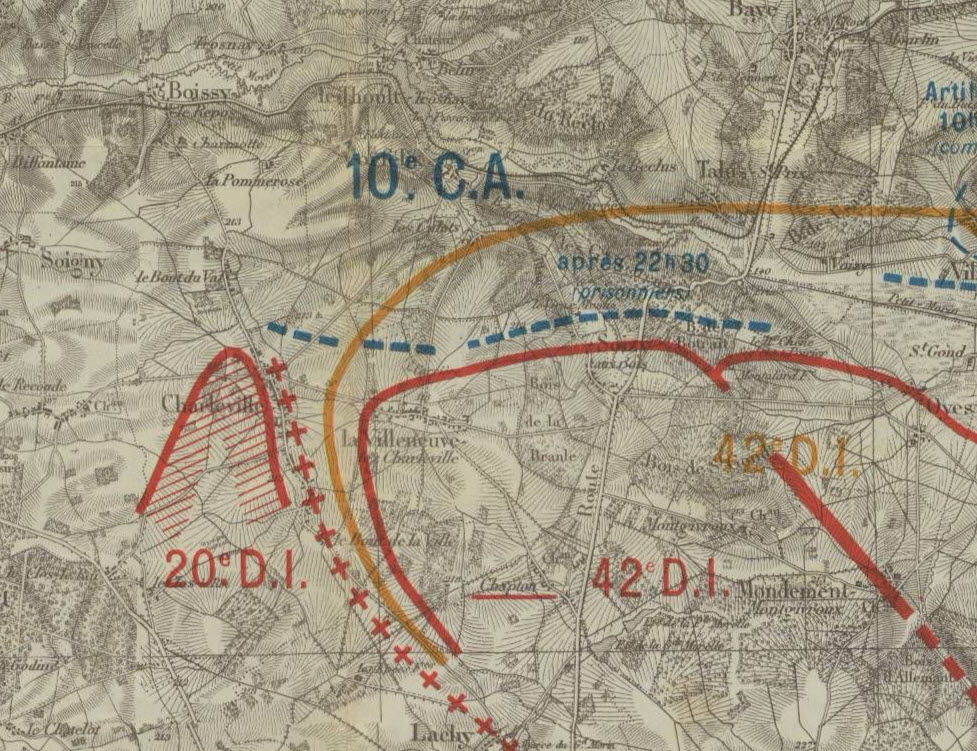
7 September: At reveille the next morning (0330 hrs), the 3 Bat. moves to the Bois de la Branle with two companies in the woods on the road between Villeneuve-lès-Charleville and Soissy, and two companies at the southeast corner of the woods. 2 Bat. Is occupying the eastern end of northern edge of the Bout-de-la-Ville woods (1500 meters south of Villeneuve), while 1 Bat. is in reserve on the western heights of Chapton.
At 0550 hrs, the regiment is ordered to retake Villeneuve-lès-Charleville. The village is not occupied by the Germans but they have been shelling it without let up. To assist the regiment, General Grossetti provides a group of artillery to back them up. 2 Bat. is ordered to attack a crest 1500 meters to the south of the church, which is oriented southeast by northwest and cut in two by a small woods. One company is deployed to the right, entrenched in individual fighting positions, another company to the left of this and the other two companies in the woods. The 3 Bat. will remain temporarily in place.
The artillery support begins around 0600 hrs, but the Germans retaliate fiercely in kind, their shrapnel beating the road from Villeneuve-lès-Charleville to Chapton, causing serious losses to the units advancing along it. 2 Bat. launches its attack at 0710 hrs in conjunction with the 94 RI. The 6 and 7 Cos. are put in the first line, 8 Co. echeloned to the left rear, and 5 Co. guarding the rear. By 0800 hrs a second artillery group from the 62 RA. The units were only able to advance slowly as both sides artillery dueled away and Villeneuve was again subjected to a fierce bombardment. The elements of the 151 only managed to reach La Villeneuve by 1000 hrs, having taken 2 hours to cover the 1,200 meters that separated the village from their point of departure in Bois du Bout de la Ville. The 5 Co. also managed to moves up to occupy the village with the other companies. Some troops unable to maneuver under artillery fire, had crammed themselves into the cellars of the ruined homes and were reluctant to come out. At 1100 hrs, 3 Bat. cooperates in the occupation of Villeneuve-lès-Charleville by sending up two companies with the other two left in the Bois de la Branle in liaison with the 94 RI. Until noon, the fighting is contained primarily to the two sides' dueling artilleries. However, at 1145 hrs regiment is advised that German forces are in the Bois de la Branle and that the new fighting line of the 42 DI must be drawn back following a retreat of the right wing. The 151 RI is ordered to hold the farm at Villeneuve-lès-Charleville, 2 Bat. and companies of 3 Bat. in Villeneuve-lès-Charleville, and 1 Bat. south of the village in the woods.
But while 151 RI had reoccupied the village, a very strong German attack was launched against 162 RI at Bois des Grandes-Garennes and Bois de Botrait, inflicting significant losses on the regiment. The 162 RI falls back first to Soizy, the southern portion of the Bois de Botrait and the Bois de Saint-Gond, and then further to the height of Montgivroux Road. With this the right wing of 42 DI bends back to the south, threatening the liaison with the Moroccan Division. The 94 RI also falls back under pressure from German attacks, forcing the 16 BCP to evacuate the Bois de la Branle to regroup at Chapton. All units are now on the fighting line and fairly mixed up with each other. It takes General Grossetti's presence in-person to stop the units from retreating further. Throughout the morning and early afternoon, a series of ebbing and flowing movements occur, all very imprecise and at times contradictory in various accounts of the day.
All units are now on the fighting line and fairly mixed up with each other. It takes General Grossetti's presence in-person to stop the units from retreating further. Throughout the morning and early afternoon, a series of ebbing and flowing movements occur, all very imprecise and at times contradictory in various accounts of the day...In the early afternoon, the Germans begin retreating all along the line. Fortunately, to the left of 42 DI the situation is better and 10 CA is able to provide reinforcements to bolster the mauled 42 DI. In the early afternoon, the Germans begin retreating all along the line. The French V Army pushes its advance forward, turning on its right wing based on the 10 CA, which remains in liaison with 42 DI. As such, 42 DI is assigned the objectives of Soizy and Saint-Prix. The 151 RI will attack the Carrière woods (north of the Villeneuve), along with the 94 RI on its left and the 162 RI, 16 BCP, and 19 BCP on its right. The 8 BCP would advance further to the east on the Montgivroux farm and château. The counter-offensive begins at 1400 hrs. (Note: there are no recorded results in the JMO of this effort save those of 2 Bat.). In reality, rather than a general and simultaneous offensive in any division, an almost constant series of sporadic movements occurs.
At 1400 hrs Villeneuve-lès-Charleville is bombarded again. In case of a retreat, 5 Co. is sent back to its preceding position from the day before. The remaining three companies (of 2 Bat.) are in the northern edge of the village. Yet once again the companies come under their own short-falling artillery, resulting in an officer and several men being wounded. The effect of the friendly-fire is the same as the previous evening. As shrapnel shells continue to burst over the men stationed at the southern edge of the village, Commandant Pascal must again order his battalion to fall back to its starting position. Pascal then reforms his battalion in order to cover the left flank of an attack directed against the Bois de la Branle.
Meanwhile, the 16 BCP makes a rapid bayonet charge down the heights to the north of Chapton until its taken in the flank by enemy machine-gun fire. The 8 BCP, having helping the advance of the 151 RI, is pulled back and rapidly marched to the northern edge of the Bois de Mondement to stop the threat against the liaison of the 42 DI and Moroccan Division. The chasseurs attack the Bois de Saint Gond and pushes the Germans out of the woods. Further west the 94 RI, 162 RI left, and 233 RI (sent over by the 51 DR), makes repeated attacks Bois de la Branle and environs, pushing the German units back.
Holding orders are given at 1800 hrs specifying that the units engaged will cover each other by advance-combat posts. Those of the 151 RI are to be positioned at Villeneuve-lès-Charleville. Those of the 94 RI would be in the southern part of Bois la Branle; the 19 BCP, 16 BCP, and 162 RI at the northern edge of the woods to the east of Chapton, near Montgivroux and the Etang (lake) de la Petite Morelle. Thus, the fighting line of the 151 RI is on the borders of Villeneuve, the 94 RI between the Bout-de-la-Ville woods and Chapton, the 162 RI to the left facing the woods, and the 8 BCP in reserve. Resupply in ammunition is done at Chapton, to the east of the road to Epernay. A note however in the JMO indicates that the resupply was not entirely fulfilled, as the next day the regiment will need to be pulled back as in the course of their advance to receive more ammunition.
Yet a 1845 hrs, Colonel Deville made the difficult decision to evacuate the village of La Villeneuve owing to the devastation caused by their own side's artillery. The 151's battalions are withdrawn slightly to the rear (south) of the village to better positions, holding the outskirts of bombarded village, which now became a sort of No-Man's-Land unoccupied by either side.
Despite the setbacks and even mild panics that had occurred on one point of the line, the units of 42 DI still performed valiantly. A breakdown had nearly occurred at the junction of the two armies (V and IX Armies). If it had occurred it surely would have spelled disaster for the French.
Left: Battle of the Marne, French left on 7 September 1914. Center: Movements of 151 RI, morning and afternoon of 7 Sept. 1914. The regiment advances back to Villeneuve but after coming under fire again from French artillery was forced to withdraw back south. Right: end of day situation on 7 September (source: AFGG).

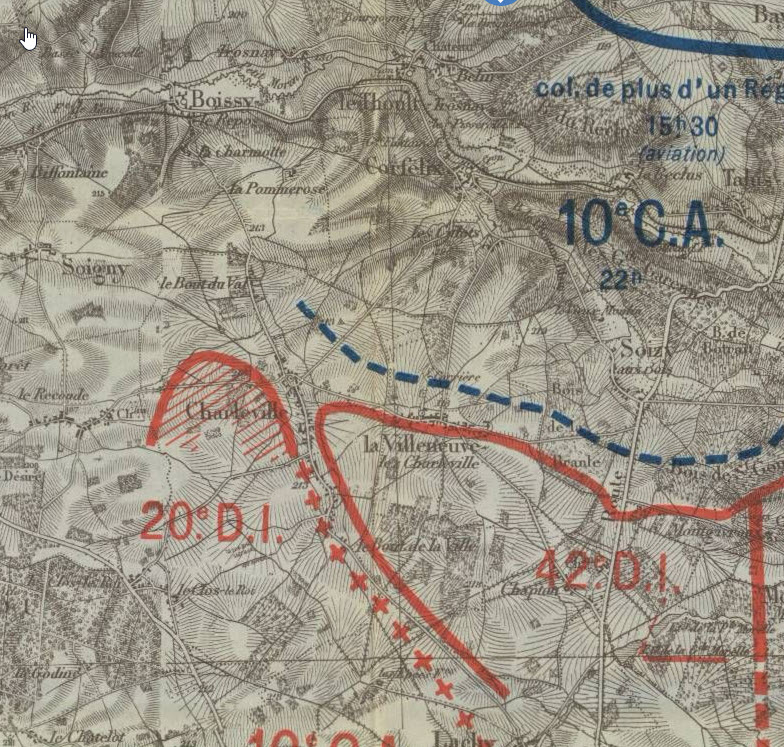
8 September: Reveille is at 0430 hrs. 2 Bat. is at Villeneuve-lès-Charleville, 1 Bat. to the northeast of the Bout-de-la-Ville woods, and 3 Bat. in reserve at the western edge of Villeneuve. The orders for the day are to continue the operations from the day before. As the Germans were no longer responding the artillery fire of the Moroccan Division (to the east), it was presumed that they were retreating and must be pursued. As such, the 151 RI was ordered to advance to Les Culots (1 km southeast of Corfélix). The 8 BCP with the squadron of the 10 BCC would advance in the direction of Baye and Champaubert; the 162 RI to Soizy-aux-Bois and Saint-Prix; the 94 RI would reconstitute to the south and west of Bois de la Branle.
At 0650 hrs the 3 Bat. is ordered to recommence its attack on the Carrière woods, which will progress up to the road perpendicular to the one leading to Les Culots (1800 meters from Villeneuve). Meanwhile, an order is received by Colonel Deville from the 7 Co. stating that a section of the company was 400 meters in front of (north) Villeneuve and a patrol even further forward, which indicated that the enemy was rapidly retreating in the direction of Montgivroux.
At 0820 hrs, Commandant Monphous reports that the 3 Bat. has reached the northern edge of a triangular wood north of the Carrière and that the enemy was occupying Corfélix and Les Culots. At 1120 hrs, 1 Bat. reports that it is 800 meters from the south corner of the Bois de l'Homme-Blanc, following the western edge of the Bois de la Branle. It is supported to the right by the 94 RI, to the left by the 2 Bat. (marching toward Les Culots and Corfélix), and behind by the 3 Bat. In order for the regiment to take Les Culots, the 1 Bat. would have to occupy the Bois de l'Homme-Blanc, advancing in double open column (4, 3 Cos. in the first line, 2 Co. in the second line echeloned). As it advances, it comes under shell fire and rifle fire from German patrols in the Bois de la Branle.
At 1130 hrs, Commandant Monphous (3 Bat.) reports that conditions were not favorable to take Les Culots as the neighboring heights were occupied by enemy machine-guns and artillery. As this report comes in, Colonel Deville instructs the 2 Bat. to advance with extreme precaution to Côte 196, while telling the 1 Bat. to also advance slowly, ensuring its right flank is covered by the 94 RI. Due to the incomplete resupply from the evening before, at 1215 hrs Deville calls back his battalions in order to distribute ammunition. 3 Bat. falls back to the little woods of the Carrière, 300 meters north of Villeneuve-lès-Charleville. 2 Bat. falls back to the cemetery north of the village. 1 Bat. falls back to the east of Villeneuve - Les Culots Road, behind and to the right of the 3 Bat. An hour later, with the resupply complete, the units are sent forward again. At 1330 hrs, orders arrive from division stating that the 151 RI was to take Les Forges, Les Reclus, and the Bois des Reclus, supported by artillery on Côte 213. The 162 RI and 8 BCP were to take Saint-Prix with the 94 RI, 16 BCP and 19 BCP in reserve. The general advance is to resume at 1530 hrs.
The 1 Bat. advances in double open column (2 and 3 Cos. followed by 4 Co.) with each echeloned to the right, 300 meters apart. By 1615 hrs, 1 Bat. has pushed up to the southwest corner of the Bois de l'Homme-Blanc. Sdt. Jules Caron would write:
Around 1730 hrs, 3 Bat. has reached Les Culots, with both battalions encountering little resistance. To the right (east) of the regiment though a lively fight had erupted at Saint-Prix, and Deville was cautioned to guard his right flank. Indeed, patrols from the 3 Co. moving through the Bois de l'Homme-Blanc up to the Soizy Road reported that the edge of the woods appeared to be occupied by the enemy.The Germans are on the run. The 151st moves towards Les Culots (near Soizy). Our unit's mission is to excavate the Bois de l'Homme Blanc, the possession of which is essential to occupy Les Culots. The enemy still maintains a few machine-gun positions to cover their retreat. The company enters the woods, stumbling among the brambles, while the needles of the fir trees scratch at our faces. We listen for the slightest noise, observing every movement. Around 1730 hrs, the patrols of the 3rd Company made it to as far as the Soizy road, then withdraws quietly to take advantage of nightfall. Stay in the ruins of the northern part of Villeneuve. Another day of life gained. En route to bivouac. The losses of the regiment amount to 600 men. The next day, the battalion leaves this heap of ruins and death, for Lachy and Broyes.
At 1830 hrs, 1 Bat. is instructed to re-establish its two companies in reserve, and to entrench to the south of the woods. The 2 and 4 Cos. dig in facing northeast upon the openings to the woods. Firing on both sides lessens and then ceases all together all along the line. Half an hour later, all battalions are instructed to hold their current positions. Advance-posts are established on the furthest points of advance and entrenchments dug. Villeneuve-lès-Charleville, lost and retaken three times, is in flames. The men were exhausted and in terrible need of sleep. Caporal Salomon, who had made coffee with some comrades in a ruined house behind the still-standing Villeneuve church, now crossed a battlefield strewn with the bodies of both sides.
Losses for all of the units of the 42 DI are significant and cause only further instability of the units. In his report, General Grossetti (commanding the division) identified faults that reflected factors rooted in failings from before the war:The dead we come across were kneeling, head resting on the arm in a position taken against the artillery fire, but facing to the rear. Other comrades in different regiments have seen the same thing elsewhere. French dead, on the other hand, are always facing toward the enemy.
Movements of 151 RI, on 8 Sept. 1914. The regiment advances past the Carrière, and up to the Bois de l'Homme-Blanc, Les Culots, and Corfélix.In today's attacks, our infantry were hit two or three times by our own artillery, and equally suffered severe losses that could have been prevented, because of [our] failure to prepare the attack with artillery fire, and [our] use of formations that were far too dense...numerous platoons stood shoulder-to-shoulder without any intervals. Two companies were deployed where one would have been sufficient.
